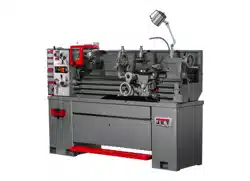Loading ...
Loading ...
Loading ...

18
4. Select desired thread using thread pitch levers
(J
2
, Figure 10-4), referring to charts on end
cover.
5. Set feed direction lever (P, Figure 10-5) to
correct position (neutral).
6. Engage half nut (N, Figure 10-5). The half nut
lever (N) and threading dial (R) are used to
thread in the conventional manner, based upon
the leadscrew, which is in Imperial units (8 TPI).
The thread dial chart (Figure 10-6) specifies at
which points a thread can be entered using the
threading dial.
NOTE: The half nut must be engaged during
the entire threading process when doing metric,
diametral, and modular threading.
7. When tool reaches end of cut, disengage and
back out tool to clear workpiece.
8. Reverse direction to allow cutting tool to return
to starting point.
9. Repeat process until desired result is obtained.
Figure 10-6
11.0 Adjustments
Lathe adjustments, especially
those involving alignment of bearings, spindle,
leadscrew, etc., should only be performed by
qualified personnel, as improper alignments can
damage the machine and/or create a safety
hazard.
Press emergency stop button
and turn off main switch before making
adjustments.
11.1 Chuck jaw reversal
The three jaws on the scroll chuck are reversible, to
hold stock with larger diameters. See Figure 11-1.
Loosen two screws with the provided hex key,
remove jaw, and rotate it 180-degrees. Reinstall
jaw, and tighten each screw incrementally until fully
tightened.
Figure 11-1
11.2 Gib/drag adjustments
After a period of time, some moving components
may need adjustment for play (or “backlash”) due to
wear. Do not overtighten gib screws as this can
hasten wear to components.
11.2.1 Saddle gib adjustment
1. Remove splash guard.
2. Loosen three hex nuts (A, Figure 11-2) at rear
of saddle.
3. Turn each of the three set screws (B, Figure 11-
2) equally with a hex wrench until a slight
resistance is felt. Do not overtighten, which can
cause premature wear of parts.
4. Move carriage with the hand wheel and
determine if drag is to your preference.
Readjust the set screws as necessary to
achieve desired drag.
5. Hold each set screw firmly with hex wrench to
prevent it from turning, and tighten hex nut to
secure setting.
Figure 11-2
11.2.2 Cross slide gib adjustment
Gib screws are located at front and rear of cross
slide opposite to one another (C, Figure 11-3).
Loading ...
Loading ...
Loading ...
